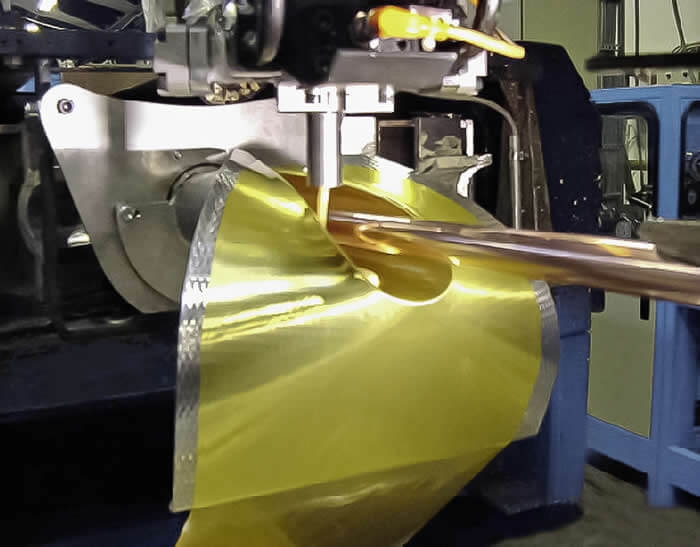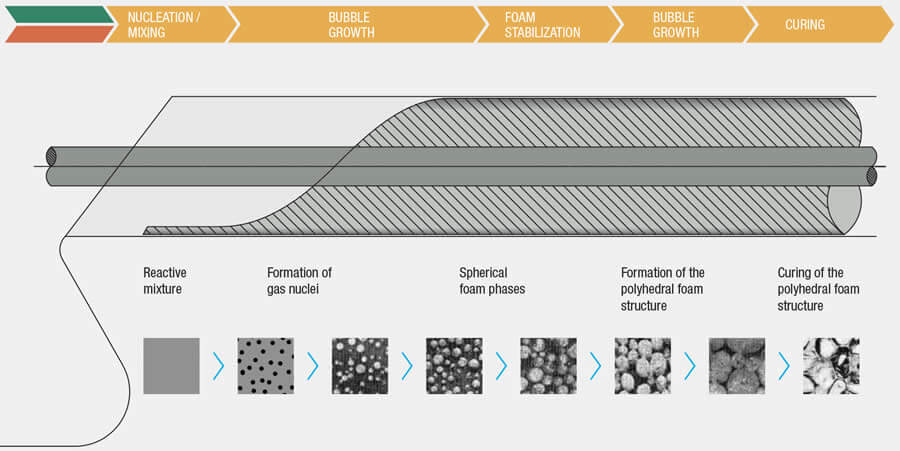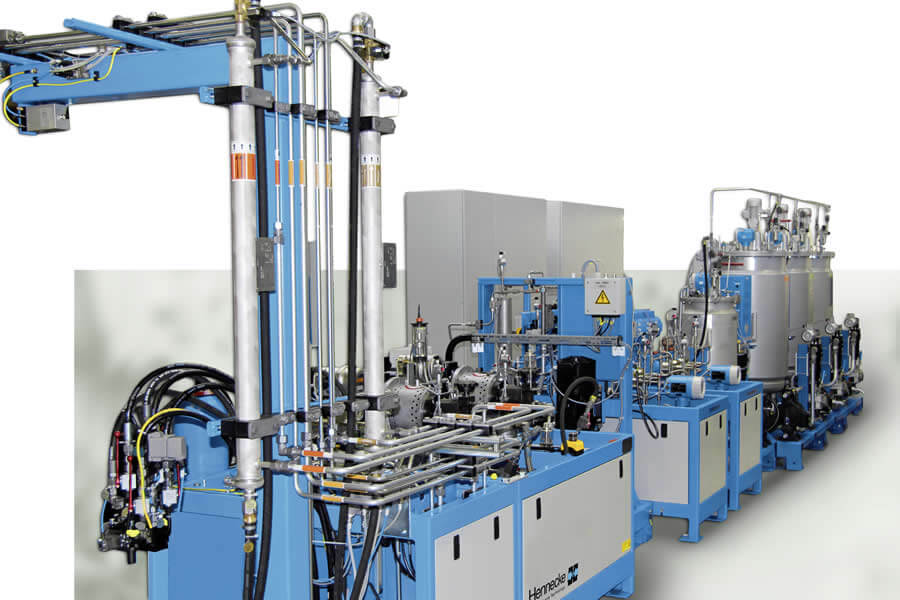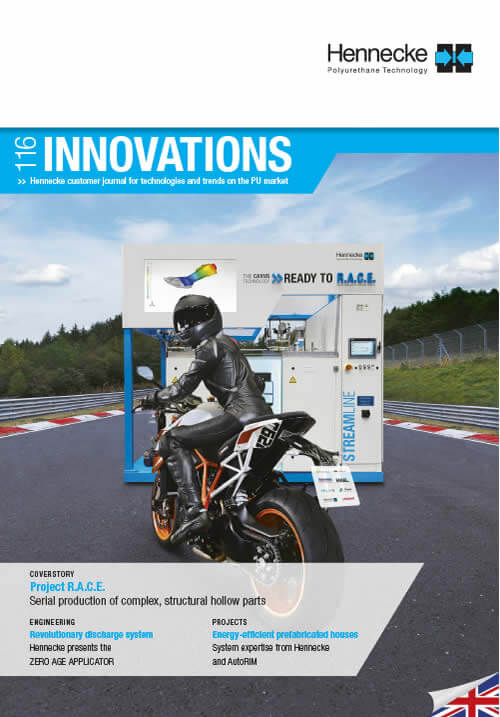Well insulated
Polyurethane high-pressure technology optimises the insulation properties of plastic-sheathed double-walled pipes
Combined heat and power is the motto when it comes to the future of energy generation. In order to save on raw materials and CO2, the residual heat that occurs when electricity is generated will no longer be able to escape unused in cooling towers but will be utilised as district heating or cooling. Insulated pipes are necessary to make sure that the heating or cooling takes place where required. The demands placed on these plastic-sheathed double-walled pipes, as they are called, in terms of insulation are steadily growing. Hennecke high-pressure metering machines for the processing of polyurethane (PU) ensure high quality.
The PU specialists at Hennecke anticipate strong growth in the market for insulated piping systems in the years ahead. Here, one factor is gaining in significance: energy loss over time. In addition, the operating costs of a piping network play an increasing role. Efficient systems ensure that the conveyed energy arrives with almost no loss. For this reason, pipes with very high insulation properties are more and more in demand. In addition, various efforts are being made around the world to protect the climate, and at the same time companies can thus make a contribution toward the effective reduction of CO2 emissions. Apart from being used in district heating technology, pre-insulated piping systems are also employed in on and offshore applications for transporting drinking water as well as oil and gas products, in the process industry and in shipbuilding.
European governments and the European Union have now been promoting combined heat and power systems for a few years. It is to be expected that this technology will also be used increasingly in Eastern Europe and other parts of the world. Today, modern combined heat and power stations, for example in Denmark, have an overall utilisation rate of more than 75 per cent. By comparison, many conventional power stations in Europe without combined heat and power only have a utilisation rate of between 25 and 30 percent because here residual heat is not used.

The plastic-sheathed double-walled pipes that are required in district heating networks commonly exist in lengths of six, twelve or sixteen metres. They are made from different materials. The component pipe is made out of steel, copper or plastic, the heat insulation is made of foamed PU and the casing pipe generally consists of polyethylene (PE). The component pipe sticks out on both sides beyond the casing so that the pipes can be joined together on the construction site. After the component pipes have been fixed together, a PE fitting is positioned over the non-cased section and the cavity is filled with PU foam.
In the meantime, PU has superseded classic materials for pipe insulation such as mineral wool. The most important reason for this is the low lambda value. This represents the heat conductivity of materials. The lower the heat conductivity, the better the heat insulation is. With lambda values of 0.020 – 0.035 W/(mK) – depending on the blowing agent – polyurethane is superior to many other insulants. If one considers the increased longevity of PU foam insulated pipes (approx. 30 years on average) in addition to these outstanding lambda values, it becomes evident that the material provides significant energy savings over time. On the other hand, the improved insulating properties also permit a reduction in foam thickness and as a result in pipe manufacturing costs. Yet another advantage resulting from the reduced foam thickness is that less the cost of transport is reduced and laying the pipes is made simpler.
Different manufacturing processes
Continuous or conventional manufacturing processes are used to produce the insulated pipes. In the conventional process, pipes with fixed lengths are manufactured one at a time. The component pipe is equipped with spacers and then fitted with a PE casing pipe. PU foam is then injected at high speed into the cavity between the component pipe and the casing pipe, which are held at a slight gradient. The foam then spreads from bottom to top. The challenge with this method is to fill the pipe with the largest possible quantity of reactive mixture within a specified time. At the same time, turbulence during the filling process must be effectively avoided to prevent any possible shrink holes from forming or fluctuations in density and hence irregular insulation. The Hennecke MXL mixhead offers all possible options for this. The conventional process is usually used for small production runs, since it has the lowest investment volume and at the same time is the most flexible and is also easy to set up and retool.
Hennecke has developed mixhead drawing technology to improve quality in single-piece production. In this process, PU foam is introduced into the cavity between the component pipe and casing pipe, much as with the conventional technique. However, the component and casing pipes are not centred by spacers. Instead they are pushed into one another and statically fixed. After this, a mixhead that is mounted on the end of a lance system is introduced into the cavity. When the mixhead is subsequently withdrawn, it dispenses a very fast-reacting foam system evenly along the entire pipe length. The foam does not have to perform any longitudinal or flow movement. Due to the laminar mixture application, the foam in the pipe attains a very uniform density distribution of 58 kg/m3 at lambda values up to 0.022 W/(mK). Compared with the conventional process, this homogeneity results in a saving on raw materials of between 10 and 15 percent. This is because with conventional production, more foam has to be cast in to achieve a defined core density everywhere in the pipe. Today, the mixhead withdrawal technique is used predominantly for pipes of small to medium nominal diameters for district heating pipes and pipelines. In the mixhead withdrawal technique, the mixture is applied using the purpose-developed MRL high-pressure mixhead, the geometry of which is matched to the pipe section.
The MRL series is cleaned with compressed air and equipped with spring-loaded, pressure-controlled nozzles. These make it possible to variably control the output in an ongoing production process while maintaining a constant mixing pressure and to keep materials circulating "on call" in low-pressure circulation without additional control elements on the mixhead. With the continuous method, the pipes are produced continuously rather than one at a time and are cut to the required length after cooling. Initially the inner pipes are endlessly fixed. At the same time, a foil is pre-formed into a U-shape. In the next step a mixhead pours the PU foam onto the foil. Then the filled foil is closed so that it envelopes the inner pipe. Afterwards, the pipe, foil and rising foam pass through a calibrating unit for curing. The foam-insulated pipe is then put into an extruder where it is coated with polyethylene. The pipe is drawn uniformly during the entire manufacturing process. The PU foam merely has to rise, as opposed to flowing a given distance as with the conventional method. As a result, even density distribution and insulation is achieved. In order to improve the insulating quality even further, the plant control permanently adapts the PU formulation to the environmental temperature. In addition, the foam front is monitored and also flows into the plant process control system.

Higher mixing quality
In the past, the PU components polyol and isocyanate were mixed with the continuous production process using low-pressure technology. In this case, blending takes place by means of a dynamic stirrer; however, deposits will form on this over the course of time. These reduce the mixing energy and hence also the mixing quality. Moreover, an uneven cell structure arose due to the escape of pentane in the mixing chamber. Further disadvantages included trapped air caused by the stirrer, the fact that the mixhead has to be cleaned with solvents after just brief operation, and the impossibility of varying the output during a production run. On the other hand, with the Hennecke high-pressure technology polyol and isocyanate are atomised with high energy according to the impingement mixing principle. This leads to a significantly improved mixing quality. Here, pentane can also be metered much more precisely. The PU foams have a completely homogeneous cell structure. The cell sizes are smaller and better distributed than with the low-pressure technology.
In addition, the equipment is more convenient to operate, providing broad output variability, simple metering of additives such as activators, less cleaning of the mixing chamber and the elimination of solvents.
For two decades, Hennecke has supplied leading pipe manufacturers throughout Europe with high-quality production plants and is the market leader in this sector with 14 installed and continuouslyproducing plants. The specialist for polyurethane technology offers corresponding equipment for all common processes for the production of PU-insulated pipes – including the processing of cyclopentane with the patented Pentane Process Technology (PPT). Depending on the production method and individual customer needs, TOPLINE HK high-pressure metering machines can be supplied in different sizes with different premixing units as well as various mixhead types.




